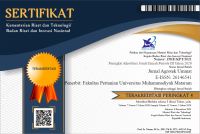The effect of sodium tripolyphosphate (STPP) concentration on the physical and chemical properties of modified yellow pumpkin starch (Modified cucurbita moschata starch)
Abstract
Keywords
Full Text:
PDF (Bahasa Indonesia)References
Adriana, L. H. (2013). Pengaruh Disodium Fosfat dan Kondisi Perendaman dalam Sifat Fisik, Kimia, dan Organoleptik Nasi Instan [Universitas brawijaya]. http://repository.ub.ac.id/id/eprint/149468/
AOAC, Horwitz, W., & Latimer, G. W. (2011). Official methods of analysis of aoac international (18th ed. 2005 revision 4). AOAC International.
Aspiyanto, & Susilowati, A. (2005). Pengarun Rasio Pati dan Air Serta Konsentrasi Na3 PO4 Dalam Pembuatan Pati Jagung (Zea mays L.) Temodifikasi Secara Gross-Linking dan Aplikasinya Pada Selai Tempe. Seminar Nasional : Teknologi Lnovatif Pascapanen Untuk Pengembangan Idustri Berbasis Pertanian, 535–548.
Breemer, R., Sigmarlatu, T., & Polnaya, F. J. (2020). Pengaruh Penambahan Sodium Tripoly-Phospahate Terhadap Karakteristik Tepung Buru Hotong (Setaria italica L Beauv.) Fosfat. AGRITEKNO: Jurnal Teknologi Pertanian, 9(2),88–95. https://doi.org/10.30598/jagritekno.2020.9.2.88
Daramola, B., & Osanyinlusi, S. A. (2006). Investigation on modification of cassava starch using active components of ginger roots (Zingiber officinale Roscoe). African Journal of Biotechnology, 5(10), 917–920. https://doi.org/10.4314/ajb.v5i10.42937
Erwiyani, A. R., Ayu, S. M., Ningtyas, W. A., & Vifta, R. L. (2022). Formulation and evaluation of pumpkin fruit (Cucurbita maxima L.) emulgel Formulasi dan evaluasi sediaan emulgel daging buah labu kuning (Cucurbita maxima L.). Jurnal Ilmiah Farmasi (Scientific Journal of Pharmacy) Special Edition, 2022, 68–78.http://journal.uii.ac.id/index.php/JIF68
Ghifarie, S. A., & Rahmawati, F. (2022). Pemanfaatan Puree Labu Kuning (Cucurbita Moschata) Pada Produk Vol Au Vent Untuk Meningkatkan Konsumsi Bahan Pangan Lokal Di Indonesia. Prosiding Pendidikan Teknik Boga Busana, 17(1). https://journal.uny.ac.id/index.php/ptbb/article/view/59329
Gui-Jie, M., Peng, W., Xiang-Sheng, M., Xing, Z., & Tong, Z. (2006). Crosslinking of corn starch with sodium trimetaphosphate in solid state by microwave irradiation. Journal of Applied Polymer Science, 102(6),5854–5860. https://doi.org/10.1002/app.24947
Hendrasty, H. K. H. H. (2003). Tepung labu kuning : pembuatan dan pemanfaatannya. Yogyakarta : Kanisius.
Ihromi, S., Sulastri, Y., Arisandi, F., & Kunci, K. (2018). Formulasi Tepung Pisang Dan Tepung Mocaf Terhadap Mutu Cake Formulation Of Mocaf Flour And Banana Flour To Quality Of Cake. Jurnal Agrotek Ummat, 5(2), 117–122. http://journal.ummat.ac.id/index.php/agrotek/article/view/702/613#
Kiatponglarp, W. (2007). Production of enzyme resistant starch from cassava starch [Suranaree University of Technology]. In Suranaree University of Technology. http://sutir.sut.ac.th:8080/jspui/handle/123456789/315
Kumoro, A. C., & Hidayat, J. P. (2018). Functional and Thermal Properties of Flour Obtained from Submerged Fermentation os Durian (Durio zibethinus Murr.) Seed Chips Using Lactobacillus Plantarum. 12, 607–614.
Mardiah, Fitrilia, T., Widowati, S., & Andini, S. F. (2020). Komposisi Proksimat Pada Tiga Varietas Tepung Labu Kuning (Cucurbita Sp) Proximate Composition Of Three Varieties Of Pumpkin Flour (Cucurbita Sp) Mardiah 1a (Vol. 6, Issue 1). https://doi.org/10.30997/jah.v6i1.2679
Mutmainah, F., Muhammad, D. R. A., & Amanto, B. S. (2013). Kajian Karakteristik Fisikokimia Tepung Sukun (Artocarpus Communis) Termodifikasi Dengan Variasi Lama Perendaman Dan Konsentrasi Asam Asetat. Jurnal Teknosains Pangan, 2(4), 46–53. https://jurnal.uns.ac.id/teknosains-pangan/article/view/4468/3814
Muzaifa M, Rozali ZF, & Rasdiansyah. (2012). Produksi roti tawar dari labu kuning dengan persentase substitusi tepung terigu dan konsentrasi emulsifier yang berbeda. Jurnal Hasil Penelitian Industri. , 25(2), 101–106.
Noverian, W., Elfrida, Suwardi, A. B., & Mubarak, A. (2020). Inventarisasi Jenis Buah-buahan Lokal sebagai Sumber Pangan bagi Masyarakat Lokop Aceh Timur. Jurnal Jeumpa, 7(1), 319–327. https://doi.org/10.33059/jj.v7i1.2956
Nursanty, N., & Sugiarti, Y. (2018). Pengaruh Tautan Silang Stpp (Sodium Tripolyphospate) Pada Pati Ganyong, Singkong dan Talas Terhadap Kadar Pati, Amilosa, Swelling Power dan Solubiity. Publikasi Penelitian Terapan Dan Kebijakan, 1(2), 36–48. https://doi.org/10.46774/PPTK.V1I2.62
Polnaya, F. J., Haryadi, Marseno, D. W., & Cahyanto, M. N. (2013). Effects of phosphorylation and cross-linking on the pasting properties and molecular structure of sago starch. International Food Research Journal , 20(4), 1609–1615. https://www.researchgate.net/publication/263051189_Effects_of_phosphorylation_and_cross-linking_on_the_pasting_properties_and_molecular_structure_of_sago_starch
Purnavita, S., & Rastono, N. K. (2021). Modifikasi Pati Aren dengan Crosslinking Agent STPP (Sodium Tri Poly Phospate) dan Penambahan Poli Vinil Alkohol terhadap Karakteristik Bioplastik. Seminar Nasional Teknik Dan Manajemen Industri, 1(1), 256–261. https://doi.org/10.28932/sentekmi2021.v1i1.73
Rahim, A., Sukmawati, S. K., Jusman, & R. If’all. (2019). Karakteristik fisikokimia pati aren fosfat asetat fosfat pada berbagai konsentrasi natrium trimetafosfat dan tripolifosfat. Buletin Palma, 20(2), 119-125. https://doi.org/10.21082/bp.v20n2.2019.119-125
Rahmi, H. (2017). Review: Aktivitas Antioksidan dari Berbagai Sumber Buah-buahan di Indonesia. Jurnal Agrotek Indonesia, 2(1). https://doi.org/10.33661/jai.v2i1.721
Raina, C. S., Singh, S., Bawa, A. S., & Saxena, D. C. (2006). Some characteristics of acetylated, cross-linked and dual modified Indian rice starches. European Food Research and Technology, 223(4), 561–570. https://doi.org/10.1007/S00217-005-0239-Z/METRICS
Richana, N., & Sunarti, T. C. (2004). Karakterisasi Sifat Fisikokimia Tepung Umbi dan Tepung Pati dari Umbi Ganyong, Suweg, Ubi Kelapa dan Gembili. . Jurnal Pascapanen , 1(1), 29–37.
Rismaya, R. (2016). Pengaruh substitusi tepung labu kuning (Cucurbita moschata D.) terhadap sifat fisikokimia, sensori dan kadar serat pangan muffin [Skripsi]. Bogor Agricultural University (IPB).
Santoso, B., Pratama, F., Hamzah, B., & Pambayun, R. (2011). Pengembangan Edible Film Dengan Menggunakan Pati Ganyong Termodifikasi Ikatan Silang [Development Of Edible Film By Using Modified Cross-Linking Ganyong Starch]. Hasil Penelitian J. Teknol. Dan Industri Pangan, XXII(2).
Suhaini, N. (2011). Pengolahan tepung labu kuning. Bandung: Jembar. Bandung : Jember.
Triyono, A. (2006). Upaya memanfaatkan umbi talas (Colocasia esculenta) sebagai sumber bahan pati pada pengembangan teknologi pembuatan dekstrin. In Seminar Nasional Iptek Solusi Kemandirian Bangsa Bidang Industri, 97–103.
Widhaswari, V. A., Dwi, W., & Putri, R. (2014). Pengaruh Modifikasi Kimia Dengan Sttp Terhadap Karakteristik Tepung Ubi Jalar Ungu [IN PRESS JULI 2014]. Jurnal Pangan Dan Agroindustri, 2(3), 121–128. https://jpa.ub.ac.id/index.php/jpa/article/view/59
Wongsagonsup, R., Kittisuban, P., Yaowalak, A., & Suphantharika, M. (2015). Physical and sensory qualities of composite wheat-pumpkin flour bread with addition of hydrocolloids. International Food Research Journal, 22(2).
DOI: https://doi.org/10.31764/jau.v10i3.15817
Refbacks
- There are currently no refbacks.
Copyright (c) 2023 Faisal, Harianto, Hutasoit, Amrullah & Ardiansyah

This work is licensed under a Creative Commons Attribution-ShareAlike 4.0 International License.

 |  |  |  |
| |||
 |  |  |
|
Alamat Kantor












